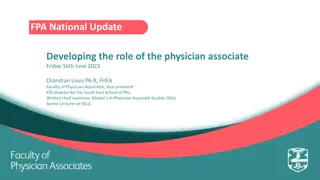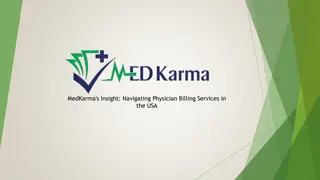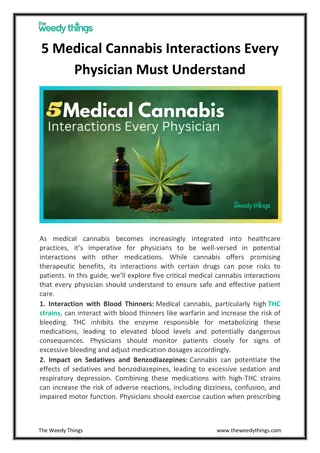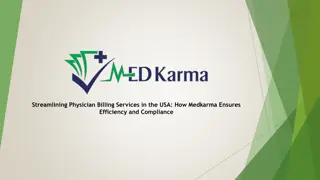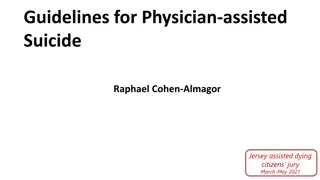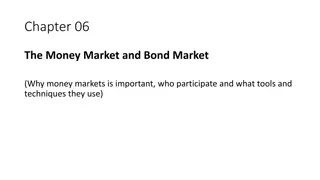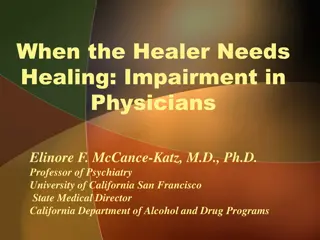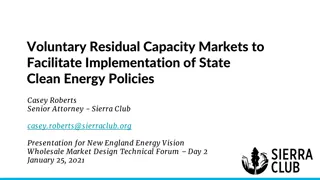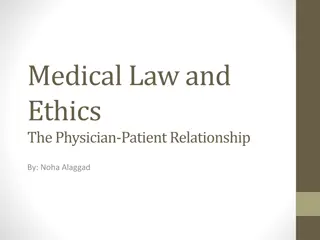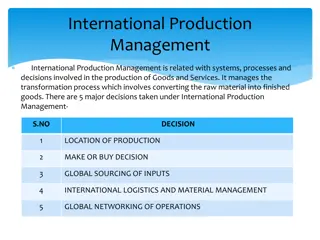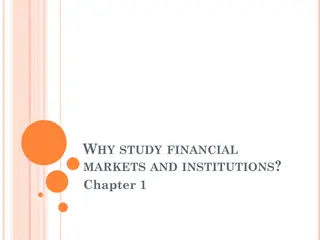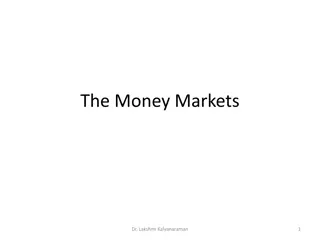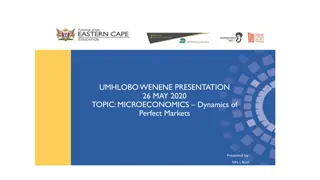Understanding Physician Location Decisions in Medical Service Markets
Explore the spatial competition model in medical service markets where physicians choose practice locations based on consumer demand. Learn about monopolistic competition, pricing strategies, consumer search behavior, advertising effects, and induced demand for medical care. Delve into case studies examining the impact of physician distribution changes in response to increased graduates.
Download Presentation

Please find below an Image/Link to download the presentation.
The content on the website is provided AS IS for your information and personal use only. It may not be sold, licensed, or shared on other websites without obtaining consent from the author. Download presentation by click this link. If you encounter any issues during the download, it is possible that the publisher has removed the file from their server.
E N D
Presentation Transcript
MODERN LABOR ECONOMICS THEORY AND PUBLIC POLICY Charles E. Phelps Health Economics 12THEDITION 6THEDITION 7 CHAPTER CHAPTER Physicians in the Marketplace 1 18 September 2024
Learning Goals Identify how doctors choose to locate their medical practices in a spatial equilibrium. Master the concepts of monopolistic competition as a way of understanding medical service markets, and understand how prices and output of each physician-firm are set in such markets. Follow the role of consumer search and how it affects physician-service markets. Understand how advertising and licensure affect these markets. Grasp the distinction between the market-level demand curve and the demand curve facing specific physician-firms. Explore the world of induced demand for medical care and its consequences. Examine various studies showing the extent of induced demand in various settings, and critique the quality of this evidence. 18 September 2024 2
7.1 Physician Location Decisions In the Hotelling (1929) model of spatial competition, identical ice cream vendors sell to customers who are uniformly distributed along a beach. A single seller would locate in the middle of the beach, with equal numbers of customers on either side. If more than one vendor exists, the new ones will compete for location by situating themselves between the existing vendor(s) and the largest possible set of customers because customers will shop at the closest possible vendor. Key idea is that each seller has the same expected number of customers. If some customers have higher income or greater desire for the product, they weigh more than others, and thus each seller can be said to face the same effective demand. 18 September 2024 3
7.1 Physician Location Decisions Now assume that the following table shows a small society with three cities and a total population of 125,000. If the total doctor:population ratio is slightly less than 1:10,000 (12 doctors), Cities A and B will have the same ratio of doctors per person but City C will have none because with a population of 5,000 it cannot compete with either City A or B to attract a new doctor. Even if the total number of doctors increases to 23, each physician will find it more profitable to enter Cities A or B than C because the effective demand per doctor would be higher there. Only when the total number of doctors exceeds 24 will City C finally attract a doctor. 18 September 2024 4
7.1 Physician Location Decisions A natural experiment conducted by U.S. medical schools during the 1970s: Following the doubling of medical school enrollment, plus the influx of foreign- trained physicians, the number of active doctors per 100,000 persons increased by almost 50 percent (from 146 to 214 per 100,000). Can observe where doctors chose to practice medicine and how that changed in response to the increase in new graduates. Under one extreme model, the new physicians would select the most desirable locations for practice, establish themselves, and induce enough demand to keep themselves content. Under the other extreme model (pure spatial competition), doctors would resettle themselves in a way corresponding to that shown in Table 7.1. This would result in the emergence of doctors in small cities where none had previously been in practice. 18 September 2024 5
7.1 Physician Location Decisions Results correspond closely with the predictions of the spatial model. Diffusion of specialists into small towns occurred only when the total doctor:population ratios became sufficiently high to make the small towns effective competitors for a new physician. The aggregate ratio of doctor:population of each of these specialists corresponds closely to the size of the town that can effectively compete for a doctor within that specialty. In 1979 there were about nine pediatricians per 100,000 population in aggregate, or about 11,000 people per pediatrician. The spatial competition model indicates that towns smaller than that should not commonly be able to attract a pediatrician. Data show that only a small fraction of towns with 5,000 10,000 people had a pediatrician, even in 1979. More than two-thirds of the towns of 10,000 20,000 citizens had attracted a pediatrician by then, and nearly all larger towns had one. 18 September 2024 7
7.1 Physician Location Decisions This and other studies confirm the importance of economic forces in physician location. Doctors respond to effective demand by locating in regions with the highest population:doctor ratio yet available. As the outpouring of doctors from medical school and immigration has increased the overall doctor:population ratio, doctors diffused across the country into increasingly small towns, just as spatial competition requires. Similar results for different specialties. Similar to the decision to specialize Both driven by the present value of future income streams and the cost of alternatives. Both involve potential barriers to entry 18 September 2024 8
7.1 Physician Location Decisions Barriers to entry for specialties are wait times to get into residency or postdoctoral programs; barrier to entry for location can be the ability to gain admitting privileges to hospitals. U.S. graduates have been considered to be more desirable and thus have an easier time gaining program admittance. Specialties with the highest U.S. graduate fill rates will have the greatest excess demand for residencies, etc. 18 September 2024 9
7.2 Consumer Search and Market Equilibrium How do doctors and patients match up, and how is price determined? If markets were perfectly competitive, it would be fairly easy to find supply and demand curves and a single market price. In reality, many prices exist in any given market area, and demand for any individual physician is downward sloping, not perfectly elastic as would be expected in a competitive market. See Box 7.1 for information on price dispersion. Better described as a monopolistically competitive market. Firms face downward sloping individual demand curves. Average cost curve is U-shaped. Firms will enter until the profit of the marginal firm is zero. P=AC, but not min AC. 18 September 2024 10
7.2 Consumer Search and Market Equilibrium A More Refined Model New approach (McGuire 2000) emphasizes the ability of the doctor to set the amount of care the patient consumes, even if the price is determined separately by insurance, government, or market forces. Patient has some minimum net benefit desired for any medical encounter Doctor attempts to maximize profits from each patient, but limited by the minimum net benefit that the patient expects The net benefit can be thought of as the patient s best approximation of the best net benefit from seeking treatment elsewhere (or deciding to forgo treatment). This puts a natural cap on the ability of the physician to extract consumer surplus from the patient, but the limits rest entirely on profit-maximizing motives of the doctor, rather than on altruistic or other considerations. 18 September 2024 11
7.2 Consumer Search and Market Equilibrium A More Refined Model, continued The patient comes to the doctor with some dollar value of NB that must be reached Doctor picks a price and quantity that maximize profits, while preserving the minimum NB for the patient. Combination of raising the price and requiring that the patient consume x* quantity. Consumer loses some surplus because of the extra consumption. The consumer would prefer to purchase x**, where the demand curve and price intersect, but the doctor only offers x*. The patient loses the dark black triangle (between x** and x*), and the medium-gray triangle to the left of x** under the demand curve has the same area. 18 September 2024 12
7.2 Consumer Search and Market Equilibrium A More Refined Model, continued A key issue is how doctors would set quantity consumed for each patient. Has implications for many aspects of physician behavior Induced demand, discussed later in the chapter Government programs may act to reduce the quantity-setting choices of physicians. Doctor-patient relationships: Building a relationship may increase the physician s ability to diagnose and to prescribe treatments that the patient will comply with. Increases ability of the doctor to extract much of the increasing net benefit over time. Sets aside widespread concerns about the ability to use demand-curve information in health care to make statements about consumer well-being (consumer surplus). Because McGuire s structure predicts virtually every observed induced demand phenomenon, it allows us to understand induced demand and at the same time carry out welfare-analysis calculations. 18 September 2024 13
7.2 Consumer Search and Market Equilibrium Quality Added to the Picture Dranove and Satterthwaite (2000) model of equilibrium cost-passthrough that incorporates the effects of both quantity and quality on supply and demand Quality has two characteristics: clinical quality and patient amenities, each of which can be produced with its own marginal cost structure. Cost of producing a medical visit as C(q, x, y) where q is the number of visits produced, x is the clinical quality, and y is patient amenities. Marginal cost of producing a physician visit is a simple linear function MC = a + bx + cy. That is, it costs a per visit with minimal quality, with linear additions of b per unit of clinical quality (e.g., time spent with the physician) and c per unit of patient amenities. Elasticities of demand (quantities) for visits to a doctor s office similar to the standard price elasticity: p is the traditional price elasticity of demand, x is the clinical quality elasticity, and y is the patient amenity elasticity. Monopolistic competition framework allows for a world where patients are either immunized from price (e.g., with excellent health insurance) and hence relatively insensitive to price, or are more sensitive to price (e.g., with no insurance). The markup rate in this world is defined by = p/(1 + p), and equilibrium price is P* = MC. If the elasticity of demand facing a single provider is 2.5, then = 2.5/ 1.5 = 5/3 = 1.6666 and P* = 1.6666 MC. 18 September 2024 14
7.2 Consumer Search and Market Equilibrium Quality Added to the Picture, continued The most interesting part of the Dranove and Satterthwaite work defines how equilibrium quality characteristics come into being. Equilibrium quality levels are defined as x* = ( x/ q)/(b/P*) and y* = ( y/ q)/(c/P*). For example, with x (clinical quality), bx*/MC = x/(1 + p), where bx*/MC is the proportion of total marginal cost accounted for by clinical quality. A similar formula holds for amenities (y). The more consumers respond to quality and the less they respond to price, the more emphasis the physician-firm will place on high quality. Similarly, if consumers don t respond much to quality, in equilibrium, a rational physician-firm will devote relatively little effort to provide quality. The Dranove and Satterthwaite (2000) model directly predicts that physician-firms will put less effort into producing quality under managed care than they would in a traditional fee-for-service market. Caveats: Makes sense only in a world where the demand elasticity exceeds 1.0 in absolute value. These are demand elasticities facing a single physician-firm, and no good measurements exist for parameters such as x or y. 18 September 2024 15
7.2 Consumer Search and Market Equilibrium Search in Monopolistic Competition The most powerful analyses of market behavior have employed the concept of consumer search in tandem with the monopolistic competition model. If patients search for the best prices or other desirable factors, then the firm must consider the tradeoff between potentially higher profits from higher prices and the chance of losing patients. The more patients search, the more competitive the market will be. Allows for different prices for different firms, depending on their cost structure. Health insurance plays two roles. Reduces the price elasticity of demand, thus increasing price dispersion May change incentives for patients to shop Less if complete coverage reduces incentives More if insurance lowers the cost of sampling other providers 18 September 2024 16
7.2 Consumer Search and Market Equilibrium Search in Monopolistic Competition, continued Growing evidence that doctors create a style of practice that best matches their own preferences and then attract patients who also prefer that style There may be less search in markets with many doctors because it is less likely that anyone will have information about a specific doctor. But price information should be easy to obtain even in a large market. Patients are likely to ask friends to obtain information about doctor styles, and the cost of this type of information gathering should be the same regardless of market size. See Box 7.3 for more discussion of patient search. Higher prices in large markets could be consistent with less patient search, but could also be explained by factors such as higher values of time in larger communities, leading to practice styles with less waiting time but higher costs. 18 September 2024 17
7.3 The Consequences of Incomplete Search Incomplete search leads to price dispersion and higher prices for those who search less. Gaynor and Polachek (1994) estimated both the effects of incomplete consumer information from limited search and incomplete physician information on how much the consumer would have been willing to pay for the service. On average, physicians missed 39 percent of the highest price they could have charged for routine office visits, but patients paid slightly more than double what the physician would have sold the service for if the patient had complete information about all providers prices in the market. Corresponds well with the predictions of the monopolistic competition model. Doctors were closer to the highest price than patients were to the lowest price. Information was weaker for procedures done less often, and so patients overpaid by a greater margin for those procedure. 18 September 2024 18
7.4 Actual Search by Patients One study shows how often and for what reasons patients do search for a new doctor. In a survey of 632 households in the Salt Lake City region in 1974, residents were asked about their use of doctors, including whether they had ever changed doctors. About 60% had changed doctors, and another 10% wished to but were deterred in some way. Major reasons given were the delays in getting an appointment were too long, they didn t like the quality of care, they sought verification of a diagnosis, or the price was too high. About one-quarter of those who switched used the recommendation of a friend (see previous discussion about search in Pauly and Satterthwaite s model). 18 September 2024 19
7.4 Actual Search by Patients One study shows how often and for what reasons patients do search for a new doctor. In a survey of 632 households in the Salt Lake City region in 1974, residents were asked about their use of doctors, including whether they had ever changed doctors. About 60% had changed doctors, and another 10% wished to but were deterred in some way (about the same rates for both high and low socioeconomic groups). See Figure 7.4 (next slide) Major reasons given were the delays in getting an appointment were too long, they didn t like the quality of care, they sought verification of a diagnosis, or the price was too high. About one-quarter of those who switched used the recommendation of a friend (see previous discussion about search in Pauly and Satterthwaite s model). 18 September 2024 20
7.4 Actual Search by Patients 18 September 2024 21
7.4 Actual Search by Patients A 2011 survey of consumers and physicians measured patients reasons for changing doctors and physicians beliefs about the likelihood of a change for the same reasons. Doctors believed that 80 percent of patients who switch would do so either because they moved or the doctor s office stopped accepting their insurance. About 40 percent of patients said they would only leave their doctor for reasons of moving or the doctor no longer accepting their insurance. Almost 80 percent said they would change doctors for reasons of service quality or convenience. Only 10 percent of doctors and patients thought that people would leave for a lower price. Both this and the earlier study suggest that consumer search for price is limited. 18 September 2024 22
7.4 Actual Search by Patients A 2017 survey suggests that search may be increasing. The survey found: Half of Americans sought price information before going to the doctor. Those with higher deductibles were more likely to seek price information. Only 20 percent of Americans actually compared prices across providers. Of those who did this, over half reported saving some money. 70 percent of Americans do not view lower prices as a sign of lower quality, and most comparison shoppers chose the lower-priced provider. Sources of price information are varied: friends, relatives, colleagues, insurance companies, doctors, and medical office receptionists were all sources of price information. Almost two-thirds of Americans want more information about prices. 18 September 2024 23
7.5 Advertising and the Costs of Information Many states once prohibited advertising for professional services. This was found unconstitutional, and now all states allow advertising. Costs: Distortion of patient choices Possible higher prices due to costs of advertising Reduction of quality if price competition increases through advertising Benefits: Reduced cost of providing information to consumers Attracting customers can lead to larger firms, leading to lower costs (and prices) due to economies of scale. Advertising is most common for procedures like laser surgery to correct vision and plastic surgery, where there is cosmetic appeal to the consumer and little insurance coverage. 18 September 2024 24
7.6 The Role of Licensure The government (at various levels) licenses physicians, registered nurses, dentists, and those in many other healing professions. Licensure is commonly supported in the belief that it protects the safety of the public from incompetence by practitioners of a profession. Licensure has both potential good and bad features. Good: maintenance of quality and the prevention of harm to patients, especially where information is hard to obtain. Can provide a floor on quality of care upon which consumers can rely without any investigation of any particular provider. Can also increase search by making price information seem more useful (in the sense that a low price would not imply too-low quality). Bad: creates a barrier to entry, decreasing competition and creating monopoly rents to those who obtain a license. 18 September 2024 25
7.6 The Role of Licensure On net, licensure can have both economically desirable and undesirable features. The capability for limiting entry obviously has some economic liabilities associated with it. However, the quality control capabilities of licensure are probably positive. One cannot say that licensure is necessarily a benefit or a harm to consumers. Medical specialty boards have aspects about them that are similar to licensure, except that they are voluntary rather than mandatory. Every doctor is supposed to have a license, but specialty certification is completely optional. Since specialty boards cannot limit entry into the medical profession, they primarily serve as indicators of quality. 18 September 2024 26
7.7 Estimates of the Demand Curve Facing Physician- Firms Doctors disperse themselves into various regions; what market conditions do they face then? One study has estimated the demand curve confronting primary-care physician-firms using survey data from the American Medical Association (McCarthy, 1985) for firms located in large metropolitan areas (defined as those with a population of more than one million). The price elasticity of the demand curve facing a typical large-city primary-care physician is quite large. In all of the various forms estimated, this study found the firm s demand curve to have an elasticity of 3 (or larger, in absolute value). Do not confuse this with the elasticity of the market demand curve, is about 0.2 to 0.3. The individual firm loses customers to other firms by raising prices, where the market as a whole loses customers only when they drop out totally due to higher prices. An elasticity of 3 certainly confirms the validity of using something other than a perfectly competitive model to explore physician markets, but it also shows that the departures from purely competitive markets cannot be huge. Longer waiting times in the office reduced demand for physician visits, holding price constant. The estimated waiting-time elasticity confronting physician-firms ranged from 0.4 to -1.1 in various versions of the model estimated. 18 September 2024 27
7.7 Estimates of the Demand Curve Facing Physician- Firms Contrary to previous empirical findings (which show higher fees with higher density), this study, which used data on individual firms rather than data at the county or standard metropolitan statistical area (SMSA) level, found that higher physician density in a region reduced the demand confronting a physician. Corresponds with to the standard monopolistic competition model, in which more firms in a community imply fewer customers per firm. Shifts inward the demand curve facing any firm, thus reducing the price it can charge. Strengthen the belief that something other than difficult search makes prices higher in markets with more doctors. The optimal price for a monopolist is inversely related to the demand elasticity confronting the firm. The optimal price is found by setting P = MC/(1 + 1/ ), where is the demand elasticity facing the firm. If = 3, then P = MC/(1 1/3) = (3/2) MC. Put differently, there would be a 50 percent markup of price above marginal cost. 18 September 2024 28
7.7 Estimates of the Demand Curve Facing Physician- Firms Excess Capacity Monopolistically competitive models predict excess capacity, production at a scale at which AC is not minimized. Most likely to arise in areas in which the demand curve facing a single physician-firm is least elastic. Markets in which search is least likely to take place and where insurance coverage is greatest offer likely targets to find considerable excess capacity. Hughes et al. (1972) examined the actual working hours and practices of surgeons, finding persistent excess capacity among surgeons, often with as much as 40 percent slack time in surgeons practices. Excess capacity is more likely to surface in other ways now that managed care has become more prominent. Managed care plans either hire surgeons directly on or else arrange for selective contracting with a narrow range of surgeons who (in exchange for a lower fee) get a considerable volume of business referred to them by the insurance program. In either case, one finds that some surgeons appear very busy while others may actually become unemployed or retire. 18 September 2024 29
7.8 Induced Demand McGuire (2000) carefully specified provider-induced demand as occurring when the physician influences a patient s demand for care against the physician s interpretation of the best interest of the patient. Implicitly, the influence financially benefits the physician. Physician disagreement about the proper treatment strategies across geographic regions would not constitute induced demand in general because we see no systematic differences in the way physician incentives differ across regions in ways that would explain geographic practice variations. The central idea stems from the observation that (with hospitals) areas that had a larger hospital bed supply had more hospital utilization (Roemer, 1961). Economists dismissed the relevance of such simple data with the observation that a competitive market would produce such results, with supply following demand into areas of high demand. Fuchs (1978) estimated the demand for surgical procedures in a number of SMSAs, holding constant price, income, and other relevant variables and using the physician supply predicted to be in a region from economic forces that could be measured. Found that as that predicted supply increased by 10 percent, the number of surgical procedures increased by 3 or 4 percent. This type of result was more disquieting to neoclassical economists because it dealt with the earlier refutation and still produced the result that supply could apparently create its own demand. See Box 7.4 for examples of the existing disagreement on the subject. 18 September 2024 30
7.8 Induced Demand A large variety of studies have offered alternative explanations for the positive association between supply and quantity demanded. More doctors may lower time costs to patients. There may be something wrong with the statistical analysis. Increasing physician supply could lead to both more office visits and fewer hospital admissions through a profit-maximizing substitution of outpatient for inpatient care. None of the related studies could show that inducement was NOT occurring, just that there were other possible explanations. If inducement can occur, some limit to inducement has to take place, or it would increase without limit. Target incomes for doctors Feelings of guilt may increase with increased inducement. Patient wariness may increase with the level of inducement. 18 September 2024 31
7.8 Induced Demand One problem is that the methodologies used to examine induced demand cannot distinguish between a case where higher demand attracts more supply and a case where supply induces demand. Dranove and Wehner (1994) used the same statistical approaches that others had used, but they attempted to explain physician-induced demand for childbirths. The idea that physicians could induce demand for childbirths is highly improbable. Their analysis showed that the standard approach to this problem leads to the absurd conclusion that obstetricians induce demand for childbirths. Because no one believes that this could actually occur, the only other logical conclusion to draw is that the methods themselves may be faulty. As in McGuire (2000) consider the consequences for demand creation with a regulated price. General tests of demand inducement most often follow one of two approaches. 1. The first begins with an exogenous shift in aggregate demand occurs that causes physicians to respond, such as the invention of a new drug that would reduce demand for physician services. 2. The second approach studies what happens when regulators or insurance plans reduce the price for a specific service. 18 September 2024 32
7.8 Induced Demand Exogenous Shifts in Aggregate Demand A class of induced demand tests looks at what happens when something changes in the market to shift (usually to reduce) aggregate demand for a physician s service. Gruber and Owings (1996) studied state-by-state differences in the reductions in birth rates (which reduce demand for obstetricians) in recent decades. Examined the frequency with which the birth takes place by Caesarian section (C-section) rather than by normal delivery. Overall in the 1970 1982 period, birth rates fell by 13.5 percent, while the number of physicians per capita was increasing. Different states had different declines in birth rates. Found that a 10 percentage point fertility drop led to a 0.6 percentage point increase in the C-section rate. Because the average C-section rate is about 20 percent, this means that a 10 percent change in birth rates created (relatively) about a 3 percent change in the rate of C-sections. 18 September 2024 33
7.8 Induced Demand The Physician as Agent for the Patient A conceptual approach that has proven quite useful in these discussions relies on the game-theory concept of agency, in which a principal (the patient) delegates authority to an agent (the doctor) to make crucial decisions. Goals of principals and agents may not be the same, and it may not be possible for the principal to fully monitor the agent. Various arrangements (contracts, agreements, and rules) emerge to try to make the agent do what the principal wants, but these are difficult to enforce in many settings. Dranove and White (1987) provide a good discussion of the role of agency in health care delivery. 18 September 2024 34
7.8 Induced Demand The Doctor/Agent Making Referrals The previous chapter discussed the possibility of fee splitting. Within the context of a principal agent model, when Dr. C (a cardiac surgeon) agrees to split any surgical fee with Dr. A (a referring cardiologist) or Dr. B (a referring internist) for any surgery undertaken, the advice from Drs. A and B will be distorted. Particularly if the patients of Drs. A and B do not know about the arrangement, they will be too willing to consult with Dr. C and, therefore, too willing to undergo surgery at the recommendation of Dr. C. An honest principal agent relationship between patient and doctor can help solve the problem of asymmetric information. If the agent (the doctor) really does provide unbiased advice about medical treatments, particularly those regarding referrals, then it would not matter how uninformed the patient was because the doctor would always provide good advice. One important role of medical ethics may be to encourage such honest agency performance. 18 September 2024 35
7.8 Induced Demand Self-Referrals : Doctors Referral to Self-Owned Facilities Doctors may refer patients to independent facilities in which they hold a financial interest, such as diagnostic radiology, medical laboratories, etc. A common practice, with, for example, at least 40% of Florida doctors having an investment in a joint venture of this type. Do these joint ventures enhance profits or improve patient care? Studies have shown that referral rates to these facilities are far higher and prices charged are greater. There are also indications that quality of care may be lower. Potentially more important area for demand inducement. Recent studies by both economists and the government support significant increases in referrals and billing for such facilities by significantly large amounts. Baker (2010): MRI use increased 26-32% in joint ventures, and billing increased by more. Related physicians outpatient billings increased by 25-43% as well. 18 September 2024 36
7.8 Induced Demand The Role of Consumer Information Several studies also attempted to measure the role of consumer information by comparing the rate at which doctors and their families received medical treatment with the rate for a more general population. Bunker and Brown (1974) and Hay and Leahy (1982) found that if anything, doctors and their families received more care than others. Casts doubt on the extent to which consumer ignorance plays a strong role in inducement. However, doctors have higher incomes and probably better insurance coverage than the comparison groups. Doctors also often receive professional courtesy from other doctors, thereby reducing the out-of-pocket price to zero. This would normally make the doctors use higher than that of others if the other groups faced any positive price. 18 September 2024 37
7.8 Induced Demand The Role of Consumer Information Several studies also attempted to measure the role of consumer information by comparing the rate at which doctors and their families received medical treatment with the rate for a more general population. Bunker and Brown (1974) and Hay and Leahy (1982) found that if anything, doctors and their families received more care than others. Casts doubt on the extent to which consumer ignorance plays a strong role in inducement. However, doctors have higher incomes and probably better insurance coverage than the comparison groups. Doctors also often receive professional courtesy from other doctors, thereby reducing the out-of-pocket price to zero. This would normally make the doctors use higher than that of others if the other groups faced any positive price. 18 September 2024 38
7.9 The Role of Payment Schemes One analysis (Woodward and Warren-Boulton, 1984) developed the ways in which payment methods might change the treatment recommendations of ethical physicians who knew what the right standard of care was and who had a utility function that included leisure and the provision of appropriate care to their patients. Three types of payments to physicians: an annual salary, a time-based wage payment, and a payment based on the number of procedures performed. Unambiguously predicts that physicians paid by the first two methods will deliver less than the right amount of care, and physicians paid on a fee-for-procedure system will deliver more than the right amount of care. A randomized controlled trial (Hickson, Altmeier, and Perrin, 1987) tested this idea. Randomly selected half of the doctors to receive a fee-for-service payment and half to be paid by flat salary. Patients coming into the clinic were also randomized as to the type of doctor they would see. The payments were set so that, on average, every doctor would receive about the same income from this activity and the profit per patient corresponded to that achieved by physicians in private practice in the community (about $2 per patient). Physicians paid by a fee for service scheduled more visits for their patients (4.9 visits per year versus 3.8 visits per year) and saw their patients more often (3.6 visits versus 2.9 visits). Almost all of the difference in behavior was due to well-care visits (1.9 visits versus 1.3 visits). 18 September 2024 39
7.9 The Role of Payment Schemes The American Academy of Pediatrics has a schedule of recommended treatment for children (well-care visits for routine examination, vaccinations, etc.), corresponding to the idea of a standard of correct care. Doctors on the fee-for-service payment system missed scheduling any of these recommended visits only 4 percent of the time, whereas doctors on the salaried group missed scheduling recommended visits for their patients 9 percent of the time. In addition, the fee-for-service doctors scheduled excess well-care visits beyond those recommended for 22 percent of their patients, while the salary doctors did this for only 4 percent of their patients. Again, supports the idea that salaried doctors may provide too little care, while fee for service doctors may provide too much care. 18 September 2024 40
7.9 The Role of Payment Schemes Changes in Per Procedure Reimbursement Two studies looked at the effects of the Medicare fee reforms for physicians that took place in 1990. The full model posits that a reduction in fees has two possible consequences: an income effect and a substitution effect. Suppose that a physician prefers more income to less (marginal utility of income is positive) but dislikes inducing demand. A reduced fee causes income to fall, putting more pressure on the earn more income side of the utility function. The guilty-conscience side of the utility function puts a brake on things. In concept, either can carry the day in terms of net observed change in behavior. In a study of the effects of the 1990 Medicare physician reimbursement changes, Nguyen and Derrick (1997) looked at the procedures for which Medicare reduced fees significantly, and added all of the effects on individual doctors practices using Medicare claims data. Overall they found no significant volume changes, but for those 20 percent of doctors hit hardest by the changes, they found a small but significant volume increase (0.4 percent total). Yip (1998) looked at the Medicare fee changes on thoracic surgeons, who were predicted to lose over a quarter of their incomes if volume remained unchanged, finding that the Medicare fee cuts led to volume increases to both Medicare and private pay patients, to the extent that 70 percent of the fee loss from Medicare was recaptured by enhanced volume. 18 September 2024 41




